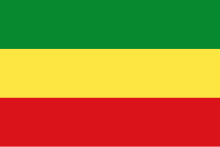Pan-African colours: Difference between revisions
fix link |
|||
| Line 10: | Line 10: | ||
==The UNIA colours== |
==The UNIA colours== |
||
[[Image:Flag of the UNIA.svg|thumb|The [[Pan-African flag|UNIA or Pan-African flag]].]] |
[[Image:Flag of the UNIA.svg|thumb|The [[Pan-African flag|UNIA or Pan-African flag]].]] |
||
The UNIA [[constitution]] defines red, black, and green as the Pan-African colours: "red representing the noble blood that unites all |
The UNIA [[constitution]] defines red, black, and green as the Pan-African colours: "red representing the noble blood that unites all pepople of African ancestry, the colour black for the people, green for the rich land of Africa."{{Fact|date=August 2007}} The [[Pan-African flag|UNIA flag]] was designated the official colours of the African Race by the UNIA at its convention in [[Madison Square Garden]] on [[August 13]], [[1920]] in [[New York City]]. |
||
==Current flags with the colours== |
==Current flags with the colours== |
||
Revision as of 18:49, 12 May 2008
Two different sets of three colours are referred to as the Pan-African colours: the green, gold, and red first used in the flag of Ghana; (Ghana was the first country to adopt the pan-African colours) and the red, black, and green adopted by the American-based Universal Negro Improvement Association and African Communities League (UNIA). As such, they are used in flags and other emblems to represent Pan-Africanism, African identity, or blacks as a race, though some flags (e.g., that of Lithuania) use these colors for unrelated reasons.
The Ethiopian colours

Green, gold, and red are now found on the national flags of many African nations. They originate in Ethiopia; from where they also have relevance for the Rastafari movement. They were used on many ancient African flags, most notably in the bloom on the flag of Granada, the Moorish state in Spain. The colours appear most prominently on the 1798 flag of Ethiopia, with the green at the bottom; however, they were accidentally flown upside-down on a state ceremony and the tradition was adopted by the Ethiopian government and by several African states, as well as by Pan-Africanist organisations around the world.[citation needed] It is now common to see these flags with green on top (or in front) of gold, and red at the bottom (or at the trailing edge) of the flag,
Except for a brief period of occupation by Italy under the Fascists, Ethiopia remained outside European control during the colonial era, and was therefore admired by many newly-independent African states. The adoption of the Ethiopian national colours was a consequence of this. The first African state to adopt a red, gold and green flag upon independence was Ghana in 1957.
The UNIA colours

The UNIA constitution defines red, black, and green as the Pan-African colours: "red representing the noble blood that unites all pepople of African ancestry, the colour black for the people, green for the rich land of Africa."[citation needed] The UNIA flag was designated the official colours of the African Race by the UNIA at its convention in Madison Square Garden on August 13, 1920 in New York City.
Current flags with the colours
The following are countries that combine three or four of red, black, green, and yellow in their flags as representative of their African identity.
Africa
Former flags with the colours
Only countries whose flags currently do not use Pan-African colours are included in this gallery.
-
Rwanda (1961–2001) -
Zaire (1971–1997) -
Cape Verde (1975-1992)
Former nations
-
Biafra (1967–1970) -
South Kasai (1960–1962)
References
- Znamierowski, Alfred (2001). The World Encyclopedia of Flags. London: Anness Publishing Ltd.


























